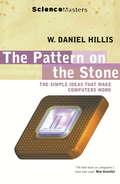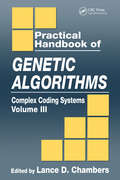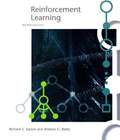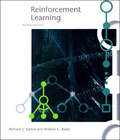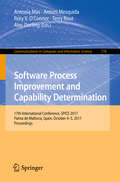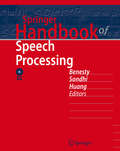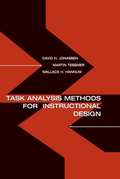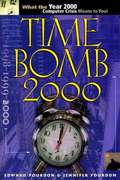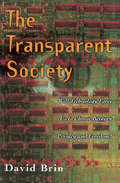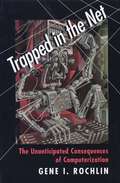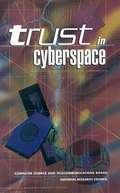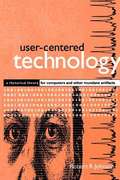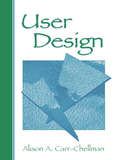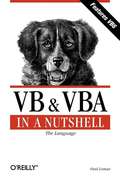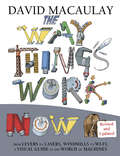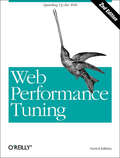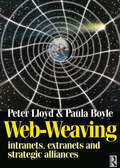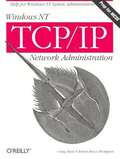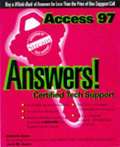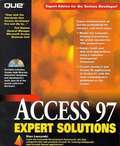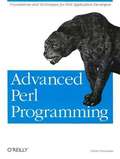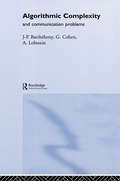- Table View
- List View
The Pattern On The Stone: The Simple Ideas That Make Computers Work (SCIENCE MASTERS)
by Daniel HillisWill computers become thinking machines? A scientist at the cutting-edge of current research gives his provocative analysis.The world was shocked when a computer, Deep Blue defeated Gary Kasparov, arguably the greatest human chess player ever to have lived. This remarkable victory, and other, more day-to-day innovations, beg serious questions: what are the limits of what computers can do? Can they think? Do they learn?Discussions of these questions tend to get muddled because most people have only the vaguest idea of how computers actually work. This book explains the inner workings of computers in a way that does not require a profound knowledge of mathematics nor an understanding of electrical engineering. Starting with an account of how computers are built and why they work, W. Daniel Hillis describes what they can and cannot do - at the present time - before explaining how a computer can surpass its programmer and, finally, where humanity has reached in its quest for a true Thinking Machine.
Practical Handbook of Genetic Algorithms: Complex Coding Systems, Volume III
by Lance D. ChambersPractical Handbook of Genetic Algorithms, Volume 3: Complex Coding Systems contains computer-code examples for the development of genetic algorithm systems - compiling them from an array of practitioners in the field.Each contribution of this singular resource includes:unique code segmentsdocumentationdescripti
Purely Functional Data Structures
by Chris OkasakiMost books on data structures assume an imperative language such as C or C++. However, data structures for these languages do not always translate well to functional languages such as Standard ML, Haskell, or Scheme. This book describes data structures from the point of view of functional languages, with examples, and presents design techniques that allow programmers to develop their own functional data structures. The author includes both classical data structures, such as red-black trees and binomial queues, and a host of new data structures developed exclusively for functional languages. All source code is given in Standard ML and Haskell, and most of the programs are easily adaptable to other functional languages. This handy reference for professional programmers working with functional languages can also be used as a tutorial or for self-study.
Reinforcement Learning: An Introduction
by Richard S. Sutton Andrew G. BartoReinforcement learning, one of the most active research areas in artificial intelligence, is a computational approach to learning whereby an agent tries to maximize the total amount of reward it receives when interacting with a complex, uncertain environment. In Reinforcement Learning, Richard Sutton and Andrew Barto provide a clear and simple account of the key ideas and algorithms of reinforcement learning. Their discussion ranges from the history of the field's intellectual foundations to the most recent developments and applications. The only necessary mathematical background is familiarity with elementary concepts of probability. The book is divided into three parts. Part I defines the reinforcement learning problem in terms of Markov decision processes. Part II provides basic solution methods: dynamic programming, Monte Carlo methods, and temporal-difference learning. Part III presents a unified view of the solution methods and incorporates artificial neural networks, eligibility traces, and planning; the two final chapters present case studies and consider the future of reinforcement learning.
Reinforcement Learning, second edition: An Introduction (Adaptive Computation and Machine Learning series #173)
by Richard S. Sutton Andrew G. BartoRichard Sutton and Andrew Barto provide a clear and simple account of the key ideas and algorithms of reinforcement learning. Their discussion ranges from the history of the field's intellectual foundations to the most recent developments and applications.Reinforcement learning, one of the most active research areas in artificial intelligence, is a computational approach to learning whereby an agent tries to maximize the total amount of reward it receives when interacting with a complex, uncertain environment. In Reinforcement Learning, Richard Sutton and Andrew Barto provide a clear and simple account of the key ideas and algorithms of reinforcement learning. Their discussion ranges from the history of the field's intellectual foundations to the most recent developments and applications. The only necessary mathematical background is familiarity with elementary concepts of probability.The book is divided into three parts. Part I defines the reinforcement learning problem in terms of Markov decision processes. Part II provides basic solution methods: dynamic programming, Monte Carlo methods, and temporal-difference learning. Part III presents a unified view of the solution methods and incorporates artificial neural networks, eligibility traces, and planning; the two final chapters present case studies and consider the future of reinforcement learning.
Software Process Improvement and Capability Determination
by Antonia Mas Antoni Mesquida Rory V. O'Connor Terry Rout Alec DorlingThe SPICE (Software Process Improvement and Capability dEtermination) Project is a joint effort by the ISO and IEC to create an international standard for software process assessment. This book covers both the theory of SPICE and its practical applications, including the lessons learned from the SPICE trials. It includes a valuable automated tool on CD-ROM to help you apply the concepts presented in the book. The text shows the evolution of the most recent developments in the SPICE project. It documents the major products and the empirical evaluations that have been conducted thus far. The book is jointly written by the key experts involved in the SPICE project. The theory chapters describe the rationale behind the architecture and the contents of the V1. 0 and V2. 0 document set and how to interpret them. The remaining chapters describe the applications and how that make use of the theory behind them.
Springer Handbook of Speech Processing
by M. M. Sondhi Jacob Benesty Yiteng HuangThis handbook plays a fundamental role in sustainable progress in speech research and development. With an accessible format and with accompanying DVD-Rom, it targets three categories of readers: graduate students, professors and active researchers in academia, and engineers in industry who need to understand or implement some specific algorithms for their speech-related products. It is a superb source of application-oriented, authoritative and comprehensive information about these technologies, this work combines the established knowledge derived from research in such fast evolving disciplines as Signal Processing and Communications, Acoustics, Computer Science and Linguistics.
Task Analysis Methods for Instructional Design
by David H. Jonassen Martin Tessmer Wallace H. HannumTask Analysis Methods for Instructional Design is a handbook of task analysis and knowledge elicitation methods that can be used for designing direct instruction, performance support, and learner-centered learning environments. To design any kind of instruction, it is necessary to articulate a model of how learners should think and perform. This book provides descriptions and examples of five different kinds of task analysis methods: *job/behavioral analysis; *learning analysis; *cognitive task analysis; *activity-based analysis methods; and *subject matter analysis. Chapters follow a standard format making them useful for reference, instruction, or performance support.
Theories of Programming Languages
by John C. ReynoldsThis textbook is a broad but rigorous survey of the theoretical basis for the design, definition, and implementation of programming languages, and of systems for specifying and proving program behavior. It encompasses imperative and functional programming, as well as the ways of integrating these aspects into more general languages. Basic concepts and their properties are described with mathematical rigor, but the mathematical development is balanced by numerous examples of applications, particularly of program specification and proof, concurrent programming, functional programming (including the use of continuations and lazy evaluation), and type systems (including subtyping, polymorphism, and modularization). Assuming only knowledge of elementary programming, this text is perfect for advanced undergraduate and beginning graduate courses in programming language theory, and will also appeal to researchers and professionals in designing or implementing computer languages.
The Transparent Society: Will Technology Force Us To Choose Between Privacy And Freedom?
by David BrinIn New York and Baltimore, police cameras scan public areas twenty-four hours a day. Huge commercial databases track you finances and sell that information to anyone willing to pay. Host sites on the World Wide Web record every page you view, and "smart" toll roads know where you drive. Every day, new technology nibbles at our privacy.Does that make you nervous? David Brin is worried, but not just about privacy. He fears that society will overreact to these technologies by restricting the flow of information, frantically enforcing a reign of secrecy. Such measures, he warns, won't really preserve our privacy. Governments, the wealthy, criminals, and the techno-elite will still find ways to watch us. But we'll have fewer ways to watch them. We'll lose the key to a free society: accountability.The Transparent Society is a call for "reciprocal transparency." If police cameras watch us, shouldn't we be able to watch police stations? If credit bureaus sell our data, shouldn't we know who buys it? Rather than cling to an illusion of anonymity-a historical anomaly, given our origins in close-knit villages-we should focus on guarding the most important forms of privacy and preserving mutual accountability. The biggest threat to our freedom, Brin warns, is that surveillance technology will be used by too few people, now by too many.A society of glass houses may seem too fragile. Fearing technology-aided crime, governments seek to restrict online anonymity; fearing technology-aided tyranny, citizens call for encrypting all data. Brins shows how, contrary to both approaches, windows offer us much better protection than walls; after all, the strongest deterrent against snooping has always been the fear of being spotted. Furthermore, Brin argues, Western culture now encourages eccentricity-we're programmed to rebel! That gives our society a natural protection against error and wrong-doing, like a body's immune system. But "social T-cells" need openness to spot trouble and get the word out. The Transparent Society is full of such provocative and far-reaching analysis.The inescapable rush of technology is forcing us to make new choices about how we want to live. This daring book reminds us that an open society is more robust and flexible than one where secrecy reigns. In an era of gnat-sized cameras, universal databases, and clothes-penetrating radar, it will be more vital than ever for us to be able to watch the watchers. With reciprocal transparency we can detect dangers early and expose wrong-doers. We can gauge the credibility of pundits and politicians. We can share technological advances and news. But all of these benefits depend on the free, two-way flow of information.
Trapped in the Net: The Unanticipated Consequences of Computerization
by Gene I. RochlinVoice mail. E-mail. Bar codes. Desktops. Laptops. Networks. The Web. In this exciting book, Gene Rochlin takes a closer look at how these familiar and pervasive productions of computerization have become embedded in all our lives, forcing us to narrow the scope of our choices, our modes of control, and our experiences with the real world. Drawing on fascinating narratives from fields that range from military command, air traffic control, and international fund transfers to library cataloging and supermarket checkouts, Rochlin shows that we are rapidly making irreversible and at times harmful changes in our business, social, and personal lives to comply with the formalities and restrictions of information systems. The threat is not the direct one once framed by the idea of insane robots or runaway mainframes usurping human functions for their own purposes, but the gradual loss of control over hardware, software, and function through networks of interconnection and dependence. What Rochlin calls the computer trap has four parts: the lure, the snare, the costs, and the long-term consequences. The lure is obvious: the promise of ever more powerful and adaptable tools with simpler and more human-centered interfaces. The snare is what usually ensues. Once heavily invested in the use of computers to perform central tasks, organizations and individuals alike are committed to new capacities and potentials, whether they eventually find them rewarding or not. The varied costs include a dependency on the manufacturers of hardware and software--and a seemingly pathological scramble to keep up with an incredible rate of sometimes unnecessary technological change. Finally, a lack of redundancy and an incredible speed of response make human intervention or control difficult at best when (and not if) something goes wrong. As Rochlin points out, this is particularly true for those systems whose interconnections and mechanisms are so deeply concealed in the computers that no human being fully understands them.
Trust in Cyberspace
by National Research CouncilWhether or not you use a computer, you probably use a telephone, electric power, and a bank. Although you may not be aware of their presence, networked computer systems are increasingly becoming an integral part of your daily life. Yet, if such systems perform poorly or don't work at all, then they can put life, liberty, and property at tremendous risk. Is the trust that we--as individuals and as a society--are placing in networked computer systems justified? And if it isn't, what can we do to make such systems more trustworthy?This book provides an assessment of the current state of the art procedures for building trustworthy networked information systems. It proposes directions for research in computer and network security, software technology, and system architecture. In addition, the book assesses current technical and market trends in order to better inform public policy as to where progress is likely and where incentives could help. Trust in Cyberspace offers insights into:--The strengths and vulnerabilities of the telephone network and Internet, the two likely building blocks of any networked information system.--The interplay between various dimensions of trustworthiness: environmental disruption, operator error, "buggy" software, and hostile attack.--The implications for trustworthiness of anticipated developments in hardware and software technology, including the consequences of mobile code.--The shifts in security technology and research resulting from replacing centralized mainframes with networks of computers.--The heightened concern for integrity and availability where once only secrecy mattered.--The way in which federal research funding levels and practices have affected the evolution and current state of the science and technology base in this area.You will want to read this book if your life is touched in any way by computers or telecommunications. But then, whose life isn't?
User-Centered Technology: A Rhetorical Theory for Computers and Other Mundane Artifacts
by Robert R. JohnsonPresents a theoretical model for examining technology through a user perspective. Begins with a historical overview of the problem of technology use through the lens of rhetoric theory, and defines central areas of user-centered theory, such as user knowledge, human-technology interaction, and technological determinism. Draws also from human factors engineering, history, philosophy, and sociology to discuss ideological presuppositions of technology design and technological determinism. Ideas are applied in academic and nonacademic contexts. Annotation copyrighted by Book News, Inc., Portland, OR
User Design
by Alison A. Carr-ChellmanUser Design offers a fresh perspective on how front-line learners (users) can participate in the design of learning environments. The author challenges the universal assumption that front-line users must be relegated to the role of offering input, and that the actual design activity of learning systems must still be conducted only by experts. The b
VB & VBA in a Nutshell: The Language
by Paul LomaxFor Visual Basic and VBA programmers, this book boils down the essentials of the VB and VBA languages into a single volume, including undocumented and little-documented areas essential to everyday programming. The convenient alphabetical reference to all functions, procedures, statements, and keywords allows programmers to use this book both as a standard reference guide and as a tool for troubleshooting and identifying programming problems.
The Way Things Work Now
by David MacaulayA New York Times Bestseller Explainer-in-Chief David Macaulay updates the worldwide bestseller The New Way Things Work to capture the latest developments in the technology that most impacts our lives. Famously packed with information on the inner workings of everything from windmills to Wi-Fi, this extraordinary and humorous book both guides readers through the fundamental principles of machines, and shows how the developments of the past are building the world of tomorrow. This sweepingly revised edition embraces all of the latest developments, from touchscreens to 3D printer. Each scientific principle is brilliantly explained--with the help of a charming, if rather slow-witted, woolly mammoth. An illustrated survey of significant inventions closes the book, along with a glossary of technical terms, and an index. What possible link could there be between zippers and plows, dentist drills and windmills? Parking meters and meat grinders, jumbo jets and jackhammers, remote control and rockets, electric guitars and egg beaters? Macaulay explains them all.
Web Performance Tuning
by Patrick KilleleaFor as long as there's been a Web, people have been trying to make it faster. The maturation of the Web has meant more users, more data, more bells and whistles, and consequently longer waits on the Web. Improved performance has become one of the most important factors in determining the usability of both the Web in general and of individual sites in particular. Web Performance Tuning is about getting the best performance from the Web. This book isn't just about tuning the web server software; it's also about getting optimal performance from a browser, tuning the hardware (on both the server and browser ends), and maximizing the capacity of the network itself. Web Performance Tuning hits the ground running, giving concrete advice for quick results--the "blunt instruments" for improving crippled performance right away. The book then takes a breath and pulls back to give a conceptual background of the principles of computing performance. The latter half of the book approaches each element of a web transaction--from client to network to server--to examine the weak links in the chain and how to strengthen them. Tips include: Using simultaneous downloads to locate bottlenecks Adjusting TCP for better web performance Reducing the impact of DNS Upgrading device drivers Using alternatives to CGI Locating the web server strategically Minimizing browser cache lookups Avoiding symbolic links for web content
Web-Weaving
by Peter Lloyd Paula BoyleIntranets and Extranets are the fastest growing use of internet technology and are being adopted by a large number of organizations. `Web-Weaving' is a book for managers which illustrates the benefits and pitfalls of using technology to enhance internal and external connections. The book brings together a number of the hottest subjects in IT and Organizational Development using contributions from innovative thinkers and practitioners in both areas. The first section defines what web-weaving actual is, describing the huge range of communication technology available to organizations at the moment. The second section reviews web-weaving in practice using case studies of companies using intranet and extranet technology. The third section brings together commentaries from leading players in both the IT and Human Resources fields to predict the future of web-weaving and the huge impact it will have on the way organizations and the people within them will work together in the future.
Windows NT TCP/IP Network Administration
by Craig Hunt Robert Bruce ThompsonWindows NT TCP/IP Network Administration is a complete guide to setting up and running a TCP/IP network on Windows NT. It starts with the fundamentals-- the protocols, routing, and setup. Beyond that, it covers all the important networking services provided as part of Windows NT, including IIS, RRAS, DNS, WINS, and DHCP. This book is the NT administrator's indispensable guide.
Access 97 Answers! Certified Tech Support
by Edward Jones Jarrel JoneskAnswers to the 1,000 most commonly asked questions about Microsoft Access. Most answers are provided in step-by-step text format with not a lot of diagrams and figures.
Access 97 Expert Solutions
by Stan LeszynskiQue's Access 97 Expert Solutions is more than a unique tutorial--it's truly a handbook, covering important topics you won't find in any other book. Beyond creating queries, forms, and reports, discover how to combine Access objects into an expert solution. This book shows you how Access application experts work--their standards, philosophies, and techniques--and how you can apply this knowledge to your own development efforts.
Advanced Perl Programming
by Sriram SrinivasanThis book covers complex techniques for managing production-ready Perl programs and explains methods for manipulating data and objects that may have looked like magic before. It gives you necessary background for dealing with networks, databases, and GUIs, and includes a discussion of internals to help you program more efficiently and embed Perl within C or C within Perl.
Algorithmic Complexity and Telecommunication Problems
by J-P Barthelmy G. Cohen A LobsteinIn this treatment of algorithmic complexity the authors explore an area fundamental to the study of the foundations of computer science. It is a topic which is at the interface of information theory, applied mathematics and computer language theory and which is rooted strongly in this book in the problems of computer communication.; Complexity theory classifies problems according to the difficulty of resolving them, while algorithms provide the computational method for solving those problems. Therefore, algorithmic complexity is concerned with establishing the best algorithm given the constraints of the computational environment and the degree of complexity.; The first three chapters present the context for a later in-depth look at applied areas of the subject, with an outline of classical complexity theory. This is followed by three chapters which explore the key area of information communication. Within this field, the book is particularly concerned with two contiguous areas which make contrasting demands on the application of algorithmic complexity. Cryptography demands the creation of extremely complex problems in order to achieve its goal of security, whereas in coding for communication the emphasis is on maximizing the compact nature of the message and providing the error correction necessary for the message to achieve optimum speed. The two must co-exist and the methods outlined in "Algorithmic Complexity" suggest a number of approaches to such problems based on extensive examples of the authors' experience.; This senior undergraduate book should be an essential read for those studying advanced topics in theoretical computer science and should provide an introduction to applied complexity for researchers and professionals alike.
